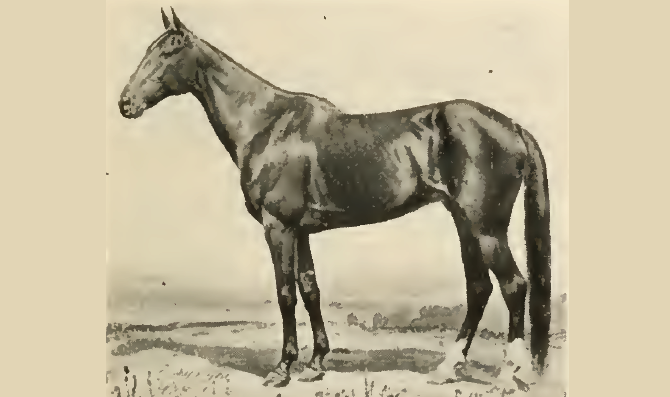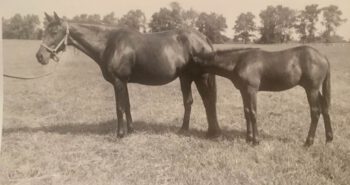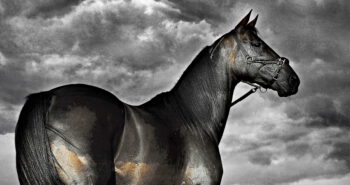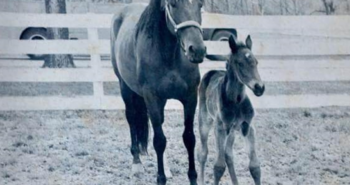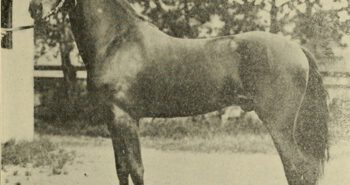He was the milk horse who turned into a world champion, but was treated badly as he was a tough cookie. Because of the treatment he received St Julien hated his trainer and driver, but the duo still worked well enough together to lower the world record three times.
The bay gelding St Julien was born in 1869 and bred by Joseph Dunning of Middletown, NY. Gelded, he spent the early part of his life pulling a milk wagon in Orange County, New Tork. He was broken to harness as a 3-year-old but not trained until the following year when he was taken to the Goshen track for training. According to an article outlining St Julien’s story in the Chicago Daily Tribute on Nov 9, 1879, while being jogged at the Goshen track, he was spotted by James Galway of New York City who was so impressed that he purchased him for $600 and at once turned him out. Galway was born in Stuartstown, Northern Ireland in 1836 came came to America around 1853 where he built up a wholesale trade.
A bottle of wine and a great career start
Nothing was done the following year, in 1874, but in the fall William Sargent “handled him some for speed, and the following winter he was driven on the road, showing considerable speed to sleigh.” He showed so much promise that later that summer the gelding was started on the Grand Circuit. The horse still didn’t really have a name and when Sargent asked Galway for a name, so that he could enter him at Poughkeepsie, the name was picked from a bottle of wine which an agent had left with him the same day.
St Julien surprised everybody with his achievements that were astonishing for such a green horse. In his fourth race, at Springfield, Massachusetts, August 27, 1875, he won the required three of five heats and trotted to a record of 2:22 1/2 (1.28,6). This time matched the winning time of the elite group that day.
To California
The following February it was announced that St Julien had been sold to California for $20,000, the buyers being Bob “RS” Morrow and Orrin A Hickok. Initial newspaper reports quote the price as $10,000, but later articles from California fixed the price at $20,000. The gelding was then taken to California where his speed was further developed and St Julien raced in both fairs and match races.
On Sep 2, 1876, at Oakland Park, he raced the famous trotter Dan Voorhees for $10,000 and won three out of four heats, the fastest in 2:25 1/4 (1.30,3). However, as St Julien had a mind of his own and would not always be all that game, Hickok worked tirelessly on the horse, keeping him away from the track for a long time.
Impressing a president
In October 1879 ex-President Ulysses Grant was returning from his tour of the world, and stopped in San Francisco. On October 25, 1879, St. Julien, then credited with being capable of 2:12 (1.22,0), was started in a time trial at Oakland Park with Grant as a spectator, to beat the record of Rarus then standing at 2:13 3/4 (1.23,1). Trotting the first quarter in 33, the half in 1:05 1/4 (1.21,1), the three-quarter in 1:40, he passed the wire in 2:12 3/4 (1.22,5) – a new world record. According to an article in the Oakland Tribune, “as he passed under the wire and the watchers marked the wonderful time, the wildest enthusiasm prevailed and General Grant seemed the happiest one of the crown and horse and driver, when they returned to the stand, received but little short of an ovation, and every one was jubilant.”
A few days after the race the owners received a $40,000 offer for St Julien, which they refused.
A rivalry with Maud S
In 1880, St Julien returned east from California to reappear on the Grand Circuit. Winning his first race in the beginning of August, it was then reported that the Rochester track had secured both St Julien and the young exceptional mare Maud S for time trials, for a purse of $2,000 to each if they beat St Julien’s existing world record. Magically both trotters ran in the same world record time, 2:11 3/4 (1.21,9). Two weeks later, on Aug 27, 1880, St Julien bettered his record in a time trial in Hartford where he ran in 2:11 1/2 (1.21,7). The gelding would not have the world record for very long, though, only 23 days; on Sep 18, Maud S lowered this time to 2:10 3/4 (1.21,3) at Rochester. St Julien, by then 11 years old, was never able to run faster than his 2:11 1/2.
On Sep 16, Maud S equalled St Julien’s 2:11 1/2 at the Red Wing Fair. St Julien, on the other hand, was involved in an accident as his train car jumped the track near Kalamazoo that morning, but fortunately the car stopped right side up with the horse square on his legs, only shaking him up. St Julien unsuccessfully kept trying to lower the record in October but constantly missed the mark by a few seconds. Later it surfaced that he had been sick and which, with the benefit of hindsight, made those efforts impressive. He return to California at the end of November, though, but went back to the East Coast the following May.
Scheduled to go against Maud S in a race on Jul 14, St Julien was scratched due to illness. The same happened for a race in Minneapolis on Aug 28. In mid-October St Julien was finally ready and went in match race again Trinket, the gelding winning all three heats in 2:12 1/2, 2:17 1/2 and 2:14 1/2 (1.22,3, 1.25,4 and 1.23,6). The same story repeated itself a week later in Philadelphia. St Julien kept racing and even though he was a great trotter, was never able to get the better of Maud S and her world record, unfortunately also struggling with illness on several occasions.
A hate that lasted a lifetime
Looking back at his career, Hickok later explained how, and why, St Julien had developed an anger, as well as a deep-rooted hate for his driver that would last a lifetime. In 1896, he went into detail how he was determined to break the gelding, but doing so made the horse permanently bitter:
“I told the others that it was of no use – I would have to break him before we would ever be able to get a dollar with him, so took him down country and started with him. The boys used to road him eighteen or twenty miles eveyr day, then we would try him on the track. He had this good days, but not very often, and the day you speak about I made up my mind he must be conquered once and for all time. I was at the track early and found they had roaded him seventeen miles. I hooked him and went over to the track to try my theory of giving him a regular siege of work.
We went five miles at a moderate clip, not at all fast. Then without taking him we walked him a little to get a change, and at it for another five miles of work. From three minutes to 2:40, and along there. Then we walked him again. This we kept up, varying it by taking the harness off and cooling him out in regular fashion. Toward 4 o’clock in the afternoon the old chap commenced to go steady – pretty tired but dead game and very stubborn. I would work him just as fast as he would go and go steady, but no mile fast at all. The last two or three miles he would let me cluck to him and would respond without the usual performances. So when he had had thirty-seven miles of track work and seventeen on the road I put the boys at work on him and went to the city, being extremely tired and, I guess you may know, fully determined to repeat the work if it was not effective.
St Julien always hated me after that and would bite at or kick at me any chance he ever got while we had him with us. But the lesson was learned that I was to do the driving and we got along fairly well together, though once in awhile he had his bad spells and caused us trouble. He was a great horse and in these days must have been as fast as Alix. We went, all told, seventy-four heats in 2:30 or better, and a lot of exhibitions. The mile you saw me drive him at Boston in 1880 in 2:13 1/4 (1.22,8) over old Beacon Park, was, in my opinion, about his best performance, for the turns were sharp, stretches short and the soil itself dead and slow by four seconds over a track like Cleveland. On his return to California in 1883 it was evident, Julien’s days as a star were over, so we decided to turn him out at Mr Morrow’s ranch. We were offered $7,500 for him and I favored a sale, but Bob couldn’t bear to sell the old fellow, so I gave in and we kept him a pensioner for life. Many a time I have seen him at pasture, with an old broncho for a companion, and as I stood watching him how many events in which he figured came to mind. Once he would catch sight of me he would come with a rush in his endeavors to chase me from the place. No one else did he hate as he did me and it was absolutely risky for me to venture to lay a hand on him, for he was just as he had been when we campaigned him, but he earned us plenty of money when he was trotting.”
It was no surprise St Julien turned out to be a good trotter as his breeding was first class. He was a son of Volunteer, a son of Hambletonian. His dam Flora, by Henry Clay, was a good broodmare, also producing Unalala 2:22 (1.28,3) and St Remo 2:28 (1.32,0). Three performers in the 2:30 list was quite an achievement for a broodmare in those days. St Julien died in 1894. He was inducted into the Hall of Fame in 1990.
St Julien
Brown gelding born in Middletown, NY in 1869. Died in California in 1894.
Volunteer – Flora Mead (Harry Clay)
T2:11 1/2 (1.21,7)
Breeder: Joseph Dunning
Owners: Joseph Dunning, James Galway, Bob “RS” Morrow & Orrin A Hickok
Trainers: Joseph Dunning, William Sargent, Orrin A Hickok
Drivers: William Sargent, Orrin A Hickok
Groom: –

